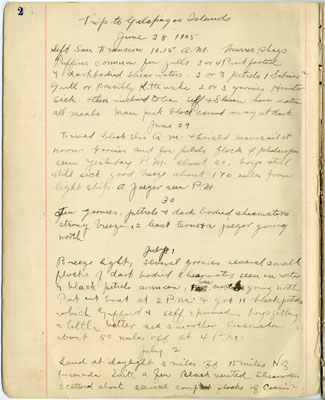
Excerpt from the Rollo Beck Galapagos expedition journal.
The California Academy of Sciences Library is pleased to announce that The Rollo Beck Galapagos Expedition Journal is now accessible online via the Biodiversity Heritage Library. The Beck field notes are the first test submission to the Connecting Content field note scanning project. Their successful inclusion into BHL marks many months of planning, effort, and collaboration between the Academy staff and our amazing partner institutions.
The Connecting Content project, made possible by an IMLS National Leadership Grant, involves digitizing field notebooks and natural history specimen collections, making the results available free for open access, and testing methods to create links between the items. This is the first step in an effort to create linked digital item-level access to archival resources, published literature, and biological data. This project has come together through the combined efforts of multiple institutions and with rigorous planning about how best to create and disseminate content that is discoverable, enduring, and openly accessible.
Rollo H. Beck was the leader of the 1905-06 expedition, and his style of field note taking provided a broader overview and unique perspective of the expedition, which differed from the very specific specimen-collecting notes of the other members of the team. The field notes are quite fragile and much care was needed to scan each page on our flatbed photo scanner. A highlight for those doing the scanning was finding the page that describes the first news of the 1906 earthquake that destroyed much of San Francisco and nearly all of the Academy of Science's collections. The specimens that the expedition brought back from the Galapagos formed the core of the new Academy.
After digitization, we had to package the materials for submission to the Internet Archive and ingest into BHL by creating a MARC (MAchine- Readable Cataloguing) record for each item. (We’d like to recognize and send a HUGE thank-you to the amazing and incredibly bright cataloguers who have toiled over this effort! Michelle Abeln at Missouri Botanical Gardens, Lisa Studier at New York Botanical Gardens, Chris Robson at Harvard University Herbaria, and our own Stella Tang here at the California Academy of Sciences, we couldn’t do this without you!) These records are then combined with a spreadsheet containing page-level metadata, and the corresponding digital files of the scanned pages are submitted to the Internet Archive, and ultimately into the Biodiversity Heritage Library.
We are now in the process of preparing several other field notebooks and our digitized specimens for our pilot scanning project, and have invited our partner institutions to begin the process of uploading their field notes in preparation for ingest into the Biodiversity Heritage Library. After the materials are scanned, input into our database, cataloged, exported, and delivered via BHL, we will use the extrapolate metadata to experiment with mash-ups and make connections between names, dates, localities, and other contextual information, published materials, and specimen data. We hope you enjoy our first submission and keep checking back often for news and progress!
-Yolanda Bustos and Kelly Jensen